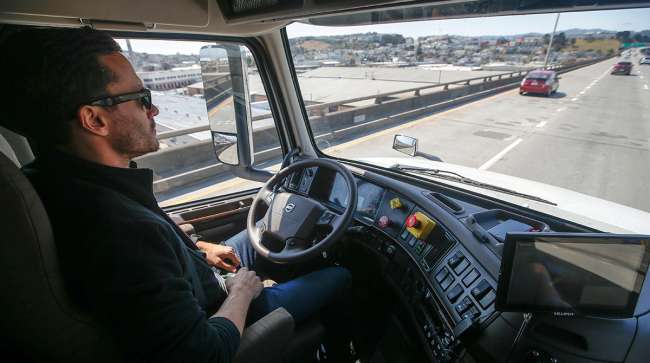Commerce Department: Autonomous Vehicle Technology Will Create Winners and Losers in Transport Industries

Workers in the trucking and other industries that move people and goods could find themselves squeezed out of those jobs by the rise of self-driving trucks.
And those workers whose jobs are dependent on mobility — such as plumbers, home-health aids, postal workers and others — could benefit from a car that drives itself.
These are some of the findings in a recently published report on autonomous vehicles by the Office of the Chief Economist at the U.S. Department of Commerce, which explored what jobs might be affected by a rise in autonomous vehicle technology — and its subsequent adoption — along with how many workers are in these jobs and the likelihood of workers in the transporting industry transitioning into other careers.
RELATED: Opinion - Why autonomous trucks won’t cost jobs anytime soon
RELATED: Unions urge slowdown as self-driving car laws pick up speed
Nationwide, some 3.8 million workers filled jobs like trucking, delivery or taxi industries in 2015. These workers were predominately male, older, less educated, and compensated less than the typical worker. Motor vehicle operator jobs are most concentrated in the transportation and warehousing sector.
Roughly 2.2 million to 3.1 million existing part- and full-time U.S. jobs may be threatened or substantially altered by autonomous vehicle technology, according to a 2016 White House report.
Meanwhile, numerous carmakers such as Ford, BMW, Fiat Chrysler and others are moving forward with developing AV technology, often partnering with technology firms like Waymo. And the trucking industry is also developing autonomous vehicle technology, perhaps emerging in various forms within the next 10 years, the study found.
RELATED: Google, Waymo officially separated by creation of XXVI Holdings Inc.
That said, there could still be plenty of time to adjust, say researchers.
“It’s not going to be right around the corner, so there might be time for people to adapt, for other jobs and so on,” said Dr. David Beede who is an economist with the Office of the Chief Economist. “Or at least, have some warning lead time before these technologies become very widespread, and used widely by businesses and so on.”
The highest concentrations of workers in the trucking business occurs in states with significant port operations, such as Texas, California and Florida. Wages vary, however. Annual mean wages stretch from about $24,000 to $34,000, according to data compiled by the U.S. Bureau of Labor Statistics.
RELATED: Federal regulators tout autonomous technology in policy update
It’s not entirely clear how the development of AV technology is playing out within the trucking or shipping industry.
“UPS doesn’t really have much to say on this topic right now,” said Kyle Peterson, a public relations spokesman for UPS, the international shipping company. “We look at any technologies that might generate network efficiencies and customer benefits. But I can’t really add much more.”
UPS ranks No. 1 on the Transport Topics Top 100 list of the largest North American for-hire carriers.
Officials with the California Trucking Association and JB Hunt, the corporate trucking giant based in Arkansas, did not return requests seeking comments on the Commerce Department study titled The Employment Impact of Autonomous Vehicles.
J.B. Hunt ranks No. 4 on the TT Top 100 for-hire list.
If truckers and cab drivers seem to be at risk of possibly losing jobs to self-driving vehicles, other industries may stand to benefit from the technology.
“It’s interesting, I think, that there are like three times as many workers for whom driving is not really their core activity, but they use, or they have to get around to deliver their services to different locations, and they may benefit in some way from autonomous vehicles,” Beede remarked, noting there are some jobs, such as police, mail service, or plumbing, that may welcome a day where not so much energy is given over to driving. For this group, which includes some 11.7 million workers — although driving is an important work activity, it is only one of many important work activities, many of which already require the kinds of non-routine cognitive skills that are becoming increasingly in demand in the U.S. economy.
“Such workers are likely to be able to adapt to the widespread adoption of AVs,” the study finds. On the other hand, workers in the more traditional trucking jobs tend to be older, less educated, “and for the most part have fewer transferable skills than other workers,” the study concluded.
“They don’t seem to have the kind of cross-structural skills, or the levels of education, that might make them more resilient to technological change compared to other job uses of autonomous vehicles,” said Beede.
Distributed by Tribune Content Agency, LLC




